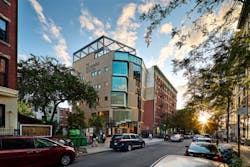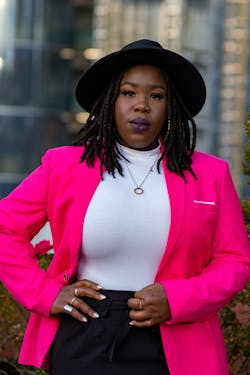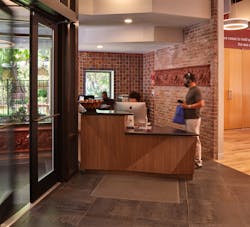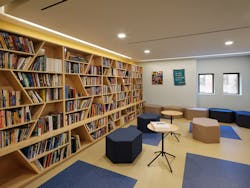Championing Equity in the A&D Industry: A Conversation with Shawnasia Black
The lack of diversity and equity in the design community is no secret. We at i+s have consistently shed light on this issue in our reporting on the industry’s demographics over the years, and historic data has supported the assertion that the profession is still dominated by white males.
Progress is being made, however, as findings from the National Council of Architectural Registration Boards’ NCARB by the Numbers: 2022 Edition indicate that there’s greater diversity in the number of candidates taking and completing the NCARB exam, as well as record holders who identify as people of color. Currently, 52% of candidates taking the exam and 34% of candidates completing it are people of color, with 60% of new record holders identifying as people of color (Hispanic or Latino, 21%; Asian, 18%, Black or African American, 7%; and Another Group, 14%).
Still, “while the diversity of earlier career stages continues to grow, the makeup of the architect population is slower to shift,” the report noted. “While white candidates made up 72% of individuals completing the path to licensure, approximately 83% of NCARB Certificate holders identified as white in 2021.”
That means there’s more work to be done, but there are trailblazers like Shawnasia Black, IIDA NY Equity Council co-chair and interior designer at Beyer Blinder Belle, who are tirelessly working to advance the cause. i+s recently caught up with Black to discuss how she became involved in justice, equity, diversity and inclusion (JEDI) initiatives and her hopes for the future of the profession.
i+s: Tell us about yourself and what led you into the profession of interior design and architecture.
Nevertheless, I had always envisioned a greater purpose for my career. In fact, I often joked about how I was planning to become the next Oprah—not for the money or fame, but because I loved how she gave with her whole heart and was able to tell the stories of the everyday people. In pursuit of this I attended Clark University in Worcester, Mass., to earn a Bachelor’s in Psychology and a Master’s in Professional Communications in 2009. However, graduating in the middle of a recession left me with an impossible task of finding a paying position in my career.
While working a series of odd jobs, a volunteer opportunity led me to a non-profit called Publicolor. It is an organization that engages underserved youth through the power of paint. Through art and math-based design programs, the students are involved in beautifying schools and community centers in their own neighborhoods while in turn receiving mentorship, vocational and scholarship opportunities. When I was eventually hired at Publicolor, I got to witness firsthand the effects of changing one’s environment. I noticed a shift in how people interacted with the spaces and even each other. And yet I still didn’t equate design as a career path for me.
Of course, with working in painting schools as my day job came requests from friends and family to paint their spaces. I was enlisted by my best friend to paint a geometric design in her bedroom of her mom’s new house. During the process her mother, Maria Lorenzo, noticed my work and attention to detail and said, “Wow, you should really go to school for this.” It was that acknowledgement that planted a seed to explore the possibility of a design career. I then researched interior design programs in New York City, which led me to FIT where I eventually graduated with a B.A. in Interior Design.
i+s: Did you have mentors or colleagues that helped or inspired you along the way?
SB: I’ve had many mentors and key players who have helped and/or inspired me along my design career path. At FIT, I remember distinctly three professors who challenged and encouraged me the most as I worked towards becoming a designer, those professors being: Shannon Leddy, Grażyna Pilatowicz, IDEC, IIDA, LEED AP and Takashi Kamiya.
Another mentor and key person in my design career was Keith Headley of Headley Menzies Interior Design. He took a chance on me and gave me my first interior design job as his assistant. He taught me the basics of how to run a successful residential interior design firm and also gave me room to grow as a designer by entrusting me to source materials FF&E for his clientele.
And most recently, Akiko Kyei-Aboagye, AIA, LEED-AP, one of the principal architects at Urban Architectural Initiatives who took me on as her mentee during my time at UAI. With a sharp mind and compassionate heart, she showed me what a well-rounded woman designer/architect should be in this typically male, dominated industry.
While each of these industry professionals played key roles in my development as an interior designer, my biggest mentor is my mother, Dawn Samuels. Despite a creative career being uncharted territory, my mother encouraged me to follow my heart when pursuing a career in interior design. It wasn’t until she was able to walk through the doors of the new headquarters for BroSis during the ribbon cutting did she truly grasp the scope of my journey. This level of support towards following my dreams is a huge departure from traditional immigrant parent's expectations from their children. Her encouragement, even at times when I second guessed myself, is the reason I am where I am today.
i+s: How and why did you become involved in championing diversity and inclusion in the A&D industry?
SB: Much like my career path into the interior design world, my journey into JEDI (Justice, Equity, Diversity & Inclusion) work was due to someone else seeing my potential. Jennifer Graham, FIIDA, LEED AP, managing principal at Workplace at Perkins&Will, reached out to me one day and asked if I would like to be a co-chair for IIDA NY chapter’s Equity Council. I had no idea what the role meant or would entail, but I’ve never known Jennifer to steer me wrong when it comes to “doing the work.” And the more I learned about Equity Council and the JEDI work that the council is trying to do within the A&D industry, the more I knew that this was how I can make a lasting impact in the design field.
For example, the project I previously mentioned and the one I am most proud of is the new headquarters and community center for BroSis, a non-profit organization, in West Harlem. The Brotherhood/Sister Sol (Bro/Sis) not-for-profit organization was founded in 1995 to provide “comprehensive, holistic and long-term support” to children between the ages of eight and 22 by providing “multi-layered support, guidance education and love to our membership, to teach them to have self-discipline and form order in their lives, and then to offer opportunities and access so that they may develop agency.”
I was the only woman onsite most days during the construction of the project and some days the men, whether they meant to or not, really made me feel the stark difference. Yet I know that this was an important project for me as it was a unique opportunity for the students that attend their programming to see a team of Black architects and designers at work, and perhaps to be inspired to pursue A&D or see a creative career as a viable option.
i+s: Can you tell us about your roles as the Equity Council Co-Chair for IIDA NY Chapter and member of the FIT Interior Design Advisory Board? What are the goals of these organizations and in what ways are they making an impact in the industry?
SB: Equity Council was founded in 2020 to foster engagement and accountability toward meaningful change in the A&D industry. Our mission is to create a more just and equitable design industry by focusing on four key pillars in the workplace: cultures of inclusion, increased racial diversity, education and communication. Equity Council seeks to bridge that gap with the Design Industry Pledge, an agreement that outlines actionable goals. It includes an assessment tool for signers to measure their progress annually. We provide educational tools and resources to use as a starting point for firms and organizations to engage in JEDI practices within their workplace. Ultimately, Equity Council is striving to become the DEI resource for the design industry. As co-chair, along with Elsie St. Léger, IIDA, WELL AP, IIDA NY past president, we provide programming and support to the Council's outreach and JEDI agenda.
We also provide a safe space within the design industry to have difficult conversations, on topics such as microaggressions, colorism, etc. We’ve heard many times from our workshop attendees that “no one else in the A&D industry is having these kinds of conversations.”
As a Board Member of the FIT Interior Design Advisory Board and given that FIT was so pivotal in launching my career as interior designer, it is an opportunity to help foster the careers of aspiring interior designers. The board is tasked with reviewing the interior design curriculum to ensure that the students are getting the most relevant and up-to-date education that will prepare them to succeed in the design world. I thought it was pivotal as a Black designer to bring my experience and inform the foundations of careers in design. Hopefully, I can encourage more black and brown youths to explore creative careers within our industry.
i+s: What inspires you to continue the work you’re doing with affordable housing and volunteer initiatives?
As far as my volunteer initiatives, I think I have my upbringing to thank for that. My family, especially my grandmother, taught me to walk this earth with a kind heart. I think also being the oldest of my siblings, I’m always willing to help in any way that I can.
i+s: What message do you want to impart to interior designers and architects about diversity and inclusion?
SB: To all interior designers and architects looking to engage in conversations of diversity and inclusion, I say to you: please check who you are inviting to the table. The beauty of this A&D industry largely stems from the diverse teams that bring physical spaces to life. I have begun to define diversity as not solely based on physical characteristics or identity, but also one’s skill sets. My work on interiors is equally as valuable as an architect's on exteriors. I have found myself in a constant position of having to validate the importance of my contributions, but then the satisfied clients and beautiful spaces I’ve created speak louder than my words.
About the Author
Robert Nieminen
Chief Content Director
Chief Content Director, Architectural Products, BUILDINGS, and interiors+sources
Robert Nieminen is the Chief Content Director of three leading B2B publications serving the commercial architecture and design industries: Architectural Products, BUILDINGS, and interiors+sources. With a career rooted in editorial excellence and a passion for storytelling, Robert oversees a diverse content portfolio that spans award-winning feature articles, strategic podcast programming, and digital media initiatives aimed at empowering design professionals, facility managers, and commercial building stakeholders.
He is the host of the I Hear Design podcast and curates the Smart Buildings Technology Report, bringing thought leadership to the forefront of innovation in built environments. Robert leads editorial and creative direction for multiple industry award programs—including the Elev8 Design Awards and Product Innovation Awards—and is a recognized voice in sustainability, smart technology integration, and forward-thinking design.
Known for his sharp editorial vision and data-informed strategies, Robert focuses on audience growth, engagement, and content monetization, leveraging AI tools and SEO-driven insights to future-proof B2B publishing.





